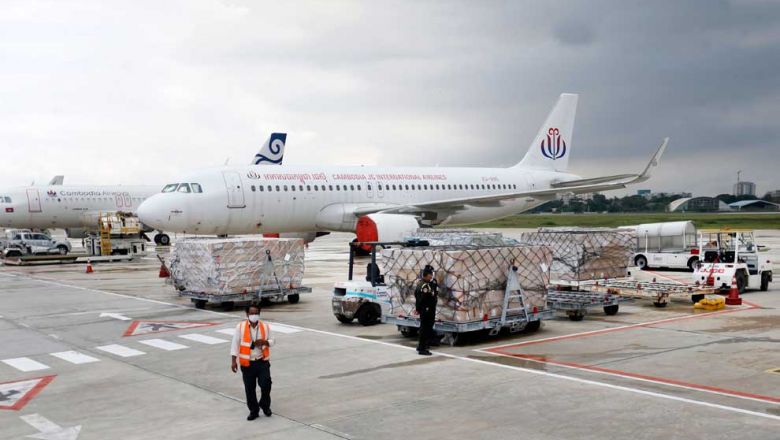Cambodia’s EU exports surge by one-quarter, pass $4B
Cambodia’s EU exports surge by one-quarter, pass $4B
Cambodian exports to the EU in 2022 were valued at $4.045 billion, registering a more than 25 per cent surge from the $3.229 billion logged in 2021, according to the Ministry of Commerce.
In a report issued in conjunction with its annual meeting late last month, the ministry reported that Cambodia-EU trade came to $4.857 billion last year, rising by 15.9 per cent from $4.190 billion in 2021, with the Kingdom’s imports from the 27-nation European bloc accounting for $812 million, dropping by nearly 16 per cent from $961 million on a yearly basis.
These figures indicate that the Kingdom’s trade surplus with the EU expanded just under three-sevenths to $3.23 billion last year, from $2.27 billion in 2021.
According to the General Department of Customs and Excise (GDCE), Germany was Cambodia’s largest EU trading partner in 2022, accounting for $1.247 billion, which was up 19.28 per cent on-year, followed by Belgium ($731.612 million; up 32.29%), the Netherlands ($596.712 million; 26.95%), France ($542.369 million; up 25.92%) and Spain ($503.778 million; up 38.66%).
Germany was also the biggest EU buyer of Cambodian goods, at $1.084 billion, marking a 23.03 per cent increase, followed by Belgium ($642.014 million; up 26.34%), the Netherlands ($552.626 million; up 25.21%), Spain ($474.764 million; up 39.05%) and France ($423.131 million; up 27.89%), GDCE figures indicate.
Combining data from both sources, the five markets – Germany, Belgium, the Netherlands, France and Spain – contributed nearly 74.6 per cent to total Cambodia-EU trade and over 78.5 per cent to the Kingdom’s exports to the bloc.
Hong Vanak, director of International Economics at the Royal Academy of Cambodia (RAC), commented that duty-free access and other trade preferences granted to the Kingdom by the EU’s ‘Everything But Arms’ (EBA) scheme have significantly boosted exports to European markets.
Even with the EU’s partial withdrawal of the tariff preferences granted to Cambodia under the EBA, exports of garments, footwear, bags, bicycles and other items remain in positive growth territory, he said.
To recap, the bloc partially withdrew the trade scheme from the Kingdom on August 12, 2020, citing perceived human and political rights concerns, in a move that reportedly affects one-fifth of Cambodia’s annual exports to the EU’s 27-nation bloc.
Regardless, Vanak stressed that the Kingdom’s economic growth over the past two decades cannot be unlinked from the active support of the EU market.
He predicted that Cambodian exports to the EU would continue on an upward trend in terms of value, and that the bloc would remain an “important market” for the Kingdom, underpinned by “quality” support for its products, even if the latter were to fully lose its EBA benefits.
He attributed the limited amount of EU imports into Cambodia to the relatively high costs for the bloc’s products.
Anthony Galliano, group CEO of Cambodia Investment Management Co Ltd, previously commented to The Post that the current geopolitical crises and trade disputes among major powers have contributed to an uptick in EU purchase orders for Cambodian products.
The EU is collectively one of Cambodia’s major trading partners, he noted, adding that the Kingdom benefits from the EBA regime.
Of note, the bloc accounted for 9.3 per cent of Cambodia’s 2022 total foreign trade, which the GDCE put at $52.425 billion.
According to Vanak, major Cambodian exports to the EU comprise milled rice, garments, footwear, travel goods, bicycles and agricultural products, while notable imports include vehicles, electrical and electronic equipment, construction materials, pharmaceuticals, and food and beverages.
Delivering the opening remarks at the commerce ministry’s annual meeting, minister Pan Sorasak underscored that the ministry remained “highly committed” in 2022 to “turning challenges into opportunities” and improving trade.
To drive the point home, Sorasak recapped that the ministry carried out “in-depth reforms in all areas; [supporting] reductions in [associated] costs and [thereby] bolstering the competitiveness of Cambodian exports; … [and promoting] a favourable environment for doing business and investing”.
The minister ascribed the export and trade growth booked last year to, among other things, bilateral and multilateral free trade agreements (FTA), as well as an uptick in exports propelled by market diversification together with preferential trade arrangements maintained by various jurisdictions.
The Cambodia Rice Federation (CRF) reported that the Kingdom’s 221,504 tonnes of milled-rice exports to the EU went to 25 countries, representing a 34.77 per cent share of the total 637,004 tonnes shipped abroad. In 2021, the Kingdom’s 155,773 tonnes of milled-rice exports to the bloc went to 22 countries.















